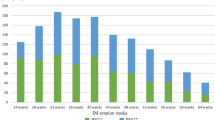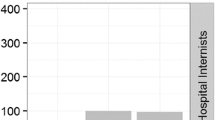ABSTRACT
Background
A shortage of primary care physicians is expected, due in part to decreasing numbers of physicians entering general internal medicine (GIM). Practicing general internists may contribute to the shortage by leaving internal medicine (IM) for other careers in and out of medicine.
Objective
To better understand mid-career attrition in IM.
Design and Participants
Mail survey to a national sample of internists originally certified by the American Board of Internal Medicine in GIM or an IM subspecialty during the years 1990 to 1995.
Main Measures
Self-reported current status as working in IM, working in another medical or non-medical field, not currently working but plan to return, or retired; and career satisfaction.
Key Results
Nine percent of all internists in the 1990–1995 certification cohorts and a significantly larger proportion of general internists (17%) than IM subspecialists [(4%) P < 0.001] had left IM at mid career. A significantly lower proportion of general internists (70%) than IM subspecialists [(77%) (P < 0.008)] were satisfied with their career. The proportion of general internists who had left IM in 2006 (19%) was not significantly different from the 21% who left in 2004 (P = 0.45). The proportion of general internists who left IM was not significantly different in earlier (1990–92; 19%) versus later (1993–95; 15%) certification cohorts (P = 0.15).
Conclusions
About one in six general internists leave IM by mid-career compared to one in 25 IM subspecialists. Although research finds that doctors leave medicine because of dissatisfaction, this study was inconclusive about whether general internists left IM in greater proportion than IM subspecialists for this reason. A more likely explanation is that GIM serves as a stepping stone to careers outside of IM.
Similar content being viewed by others
REFERENCES
Dill MJ, Salsberg ES. The complexities of physician supply and demand: projections through 2025. Association of American Medical Colleges, Center for Workforce Studies. 2008 Oct. Accessed at www.aamc.org on 24 March 2010.
Robinson L, editor. AAMC data book. Statistical information related to medical schools and teaching hospitals. January 2002 edition. Washington, DC: Association of American Medical Colleges; 2002. (Table B13)
Brandeburg K, Gaillard S, Geraci W, Vassev P, Youngclaus J, editors. AAMC data book. Medical schools and teaching hospitals by the numbers. May 2008 edition. Washington, DC: Association of American Medical Colleges; 2008. (Table B14)
Salsberg E, Rockey PH, Rivers KL, Brotherton SE, Jackson GR. US residency training before and after the 1997 Balanced Budget Act. JAMA. 2008;300:1174–80 [PMID: 18780846].
National Residency Matching Program. Results and Data 2008 Main Residency Match; 2008. Accessed at www.nrmp.org on 24 March 2010.
Zuger A. Dissatisfaction with medical practice. N Engl J Med. 2004;350:69–75 [PMID: 14702431].
Mechanic D. Physician discontent: challenges and opportunities. JAMA. 2003;290:941–946 [PMID: 12928472].
Jauhar S. Eyes bloodshot, doctors vent their discontent. New York Times. 2008 June 17. Accessed at www.nytimes.com on 24 March 2010.
Steiger B. Special report: discouraged doctors. Survey results: doctors say morale is hurting. The Physician Executive. 2006; Nov-Dec:6–15.
Landon BE, Reschovsky JD, Pham HH, Blumenthal D. Leaving medicine: the consequences of physician dissatisfaction. Med Care. 2006;44:234–242 [PMID: 16501394].
Tu HT, Ginsburg P. Losing Ground: Physician income, 1995–2003. Tracking Report No. 15. 2006 Jun: Jun;1–5. Accessed at www.hschange.com on 24 March 2010. [PMID 16791996]
Bodenheimer T, Berenson RA, Rudolf P. The primary care-specialty income gap: why it matters. Ann Intern Med. 2007;146:301–6 [PMID: 17310054].
Bodenheimer T. Primary care—will it survive? N Engl J Med. 2006;355:861–864 [PMID: 16943396].
Lipner RS, Bylsma WH, Arnold GK, Fortna GS, Tooker J, Cassel CK. Who is maintaining certification in internal medicine--and why? A national survey 10 years after initial certification. Ann Intern Med. 2006;144:29–36 [PMID: 16389252].
Liebhaber A, Grossman JM. Physicians moving to mid-sized, single-specialty practices. Track Rep. 2007 Aug;(18):1–5. Accessed at www.hschange.com on 22 October 2008. [PMID: 17710764]
Lowes R. Group practices pay better. Medical Economics. 2007;16 Nov:23-5. [PMID: 18159882]
Acknowledgements
The American Board of Internal Medicine Foundation and the American College of Physicians, Inc., funded the study.
Conflict of Interest
The lead author is employed by the American College of Physicians, Inc; other authors are employed by the American Board of Internal Medicine. Both organizations may benefit financially as the number of general internists increases.
Author information
Authors and Affiliations
Corresponding author
APPENDIX
APPENDIX
Survey Instrument
Respondents described their current status as (a) working in the field of IM or its subspecialties; (b) working in a medical field other than IM or its subspecialties; (c) working in a non-medical field; (d) not currently working but plan to return to IM or its subspecialties; or (e) retired. Respondents currently working but not in IM (b and c above) were asked to write in a response to the question “Why did you leave internal medicine or its subspecialty areas?” and to indicate whether or not they (a) intend to return to IM or its subspecialties, (b) might consider returning, or (c) do not intend to return. Current and past primary employer, principal medical specialty, and number of physicians in practice or primary work setting were assessed with close-ended response options. US region, location of medical school, and gender were obtained from ABIM’s administrative records. Respondents indicated their career satisfaction by answering the question “Thinking very generally about your overall satisfaction with your current career, how satisfied are you right now?” (-2= very dissatisfied; -1= somewhat dissatisfied; 0= neutral; +1= somewhat satisfied; +2= very satisfied).
Rights and permissions
About this article
Cite this article
Bylsma, W.H., Arnold, G.K., Fortna, G.S. et al. Where Have All the General Internists Gone?. J GEN INTERN MED 25, 1020–1023 (2010). https://doi.org/10.1007/s11606-010-1349-2
Received:
Revised:
Accepted:
Published:
Issue Date:
DOI: https://doi.org/10.1007/s11606-010-1349-2




